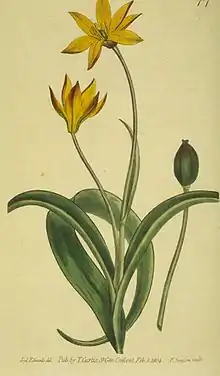Tulipeae
The Tulipeae (syn. Tulipoideae) Duby[1] is a tribe of monocotyledon perennial, herbaceous mainly bulbous flowering plants in the Liliaceae (lily) family. As originally conceived by Duby (1828), "Tulipaceae" was a tribe within Liliaceae, consisting of the genera Tulipa, Fritillaria and Lilium. [1]

Description
Herbaceous non-climbing bulbous plants. Bulbs consisting of a single scale. Anthers pseudo-basifixed. fruit consists of a loculicidal capsule, seeds not winged. Tetrasporic embryo-sac formation with 7–8 nuclei. Nucella having a short base. Vesicular-arbuscular mycorrhizae (VAM) non-Clintonia type. Chromosomes large - 2–11 μm (1–6 μm in Gagea). Genome size (3)4–25(70) pg, x = (9)12. Polyploidy common.[2]
Taxonomy
Tulipeae remained a core group of the Liliaceae, containing the type genus, Lilium for most of its taxonomic history. For instance, Bentham and Hooker (1883),[3] placed Lilium together with Tulipa and five other genera in Liliaceae tribe Tulipeae.
In the modern era, Takhtadzhi︠an described the tribe as having four genera:[4]
- Tulipa
- Amana (considered by some to be included in Tulipa)
- Holongia[lower-alpha 1]
- Erythronium
Later only Tulipa and Erythronium were included, and Gagea was added. Tulipeae has been variously constructed, chiefly as either a tribe of the subfamily Lilioideae,[5] or a subfamily of Liliaceae itself (Tulipoideae).[6] However it has been proposed that Gagea should be in its own tribe, the Lloydieae.[7]
The evolutionary and phylogenetic relationships of Tulipeae within Liliaceae are shown in the following Cladogram.
| Cladogram: Phylogeny and biogeography of the genera of the Liliaceae | ||||||||||||||||||||||||||||||||||||||||||||||||||||||||||||||||||||||||||||||||||||||||||||||||
| ||||||||||||||||||||||||||||||||||||||||||||||||||||||||||||||||||||||||||||||||||||||||||||||||
| Phylogenetic tree reflecting relationships based on molecular phylogenetic evidence. *=Liliaceae sensu Tamura; EA=Eurasia NA=North America |
Here, Tulipeae is shown as a clade within the broader construction of Lileae (sensu lato), or as a separate biogeographical tribe if the narrow sense of Lileae (sensu stricto) is adopted, with Lileae and Tulipeae as sister groups. The continuing use of Tulipeae as a separate tribe is supported by several authors.[7][2]
Genera
Genera (species)[2]
- Amana Honda (5)
- Erythronium L. (15)
- Gagea Salisb. (=Lloydia Salisb.) (ca. 300)
- Tulipa L. (ca. 150)
Gagea is sister to the other three genera.
Synonyms
- Gageeae Rouy, Fl. France 12: 380. 1910.
- Lloydieae Buxb., Bot. Arch. 38: 389. 1937.
- Tulipoideae Kostel, Allg. Med.-Pharm. Fl. 1: 168. 1831.[2]
Notes
- Holongia: A genus only recognised by Takhtadzhi︠an
References
Bibliography
- Bentham, G.; Hooker, J.D. (1862–1883). "Tulipeae". Genera plantarum ad exemplaria imprimis in herbariis kewensibus servata definita (in Latin). Vol. 3. London: L Reeve & Co. pp. 759–760.
- Brands, S.J., ed. (25 April 2017). "Tribe Tulipeae". Systema Naturae 2000. The Taxonomicon. Universal Taxonomic Services. Retrieved 11 October 2017.
- Duby, Jean Étienne (April 1828). "Tulipaceae". Botanicon Gallicum; seu, Synopsis plantarum in flora Gallica descriptarum 2 vols. Vol. 1 (2nd ed.). pp. 461–463.
- F. Buxbaum (1937), "Die Entwicklungslinien der Lilioideae. II. Die systematische Stellung der gattung Gagea", Botanisches Archiv (in German), vol. 38, pp. 305ff
- Peruzzi, L.; I. J. Leitch; K.F. Caparelli (2009). "Chromosome diversity and evolution in Liliaceae". Annals of Botany. 103 (3): 459–475. doi:10.1093/aob/mcn230. PMC 2707325. PMID 19033282.
- Baker, J. G. (1874). "Revision of the Genera and Species of Tulipeae". Journal of the Linnean Society of London, Botany. xiv (76): 211–310. doi:10.1111/j.1095-8339.1874.tb00314.x.
- Leitch, I. J.; Beaulieu, JM; Cheung, K; Hanson, L; Lysak, MA; Fay, MF (November 2007). "Punctuated genome size evolution in Liliaceae". Journal of Evolutionary Biology. 20 (6): 2296–308. doi:10.1111/j.1420-9101.2007.01416.x. PMID 17956392. Retrieved 26 January 2014.
- Kim, Jung Sung; Hong, Jeong-Ki; Chase, Mark W.; Fay, Michael F.; Kim, Joo-Hwan (May 2013). "Familial relationships of the monocot order Liliales based on a molecular phylogenetic analysis using four plastid loci: matK, rbcL, atpB and atpF-H". Botanical Journal of the Linnean Society. 172 (1): 5–21. doi:10.1111/boj.12039.
- Peruzzi, L. (11 January 2016). "A new infrafamilial taxonomic setting for Liliaceae, with a key to genera and tribes". Plant Biosystems. 150 (6): 1341–1347. doi:10.1080/11263504.2015.1115435. S2CID 88042387.
- Takhtadzhi︠a︡n, Armen Leonovich (2009). Flowering Plants. Springer. ISBN 978-1402096099.
- Watson, Sereno (1879). "Revision of the North American Liliaceae: Descriptions of Some New Species of North American Plants". Proceedings of the American Academy of Arts and Sciences. XIV: 213–312. doi:10.2307/25138538. JSTOR 25138538. Retrieved 6 January 2014.